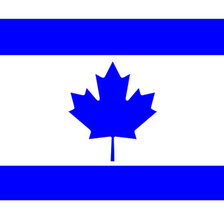The Electronic Intifada 6 July 2010

Pocket-sized, thin and with an appendix of web sources for activists, the book may be easily pigeonholed as an anti-Zionist activism manual. But Engler, an iconoclast of Canada’s foreign policy mythmaking, delves deep into the diplomatic, economic, ideological, religious and security ties between the two countries that span over a century. The material is already out there, but the author skillfully constructs a coherent narrative that brings it together into one accessible volume. His well-referenced and easy-to-follow exposé leaves little doubt of the strength and longevity of the Canada-Israel relationship.
More arguably perhaps, Engler adheres to a Chomskian interpretation of this alliance. Namely that it is driven more by Canada’s backing of American-led imperialism rather than the appeasement of the Zionist lobby. The latter, Engler claims, plays an undeniable role in funding Israeli apartheid. But in terms of steering policy in Ottawa, it is pushing against an open door. Ottawa, the author says, is already sold on backing a satellite of imperialism like Israel in the Middle East. Meanwhile, the Jewish vote in Canada is too scattered to make a substantial difference in most electoral districts.
Engler stresses the fact that the roots of Zionism in Canada are Christian rather than Jewish. He chronicles Canada’s involvement at every state of Zionist history by citing the prominent role Canadian Zionists played at each of those stages: businessman and Christian Zionist Henry Wentworth Monk was campaigning to raise funds and buy land in Palestine long before Herzl “thought of a Jewish state.” In 1881, Monk proposed setting up a National Jewish Fund. Clergymen like Albert Thompson and Charles Russell spoke of turning the “wilderness” of the holy land into the “very garden of the lord.” But Monk’s efforts bore little financial fruit. By 1906, Canadian Zionism had raised a mere $6,000 in support funds. Things changed during the First World War. Close to 400 Canadian soldiers took part in British General Allenby’s invasion of Ottoman Palestine. Some were mobilized by then-president of Zionist Societies of Canada Clarence De Sola. Following the war and Britain’s Balfour Declaration in November 1917, which declared support for a Jewish national home in Palestine, Canadians raised close to half a million dollars for Zionism between 1919 and 1921 — a giant increase compared to Monk’s time.
The Canadian military contribution to the British conquest of Palestine turned into outright participation in the 1948 Palestine War and the Nakba, the forced expulsion of Palestinians from Palestine. The main recruiter for the Zionist Haganah militia in Canada — and heir to giant retailer Tip Tops — Ben Dunkelman put the number of Canadians who fought to establish Israel at 1,000. Canadian participation left its clearest mark perhaps on Israel’s air force. Engler states that the Zionists’ central base commander was Canadian Sde Dov while Canada’s most decorated Jewish serviceman Sydney Shulemson is considered the “father of the Israeli air force.” At least 53 Canadians are believed to have enlisted in Israel’s small air force during the 1948 war.
The birth of Israel also marked another watershed in Canada’s commitment to Zionism at the official level. This is symbolized by the influential role of one of Canada’s most revered Prime Ministers, Lester B. Pearson. Pearson was Undersecretary of State for External Affairs at the time and chaired the UN Committee on Palestine in 1947 (UNSCOP). Canadian Supreme Court Justice Ivan Rand was also a member of the commission and is considered by some as the chief architect of the UN’s partition plan of Palestine. Pearson actively lobbied and advocated for the partition plan. Engler identifies the Pearson era as a time of gradual transfer of Canada’s services from British-led imperialism to those of the United States. Canada for instance gladly obliged when the Eisenhower administration was hesitant to directly sell heavy weapons to Israel lest it upset Arab governments and by extension Washington’s Cold War planning in the region. Ottawa struck the arms deals in lieu of Washington.
The weapons sales, among other things, set the stage for a much more institutionalized form of cooperation between Canada and Israel that spanned the intelligence, military and business fields. Engler cites reports by Canadian diplomats on the close cooperation between the two countries’ spy agencies. The Canadian Security and Intelligence Service (CSIS) and Israel’s Mossad not only share information, but also conduct joint operations according to these sources.
One of the most contentious issues surrounding joint security operations is the use of Canadian passports in Israeli assassination operations. Israeli agents who carried out the 1997 botched assassination attempt of Hamas leader Khaled Meshal in Amman entered Jordan on Canadian passports. Although the Mashal incident brought the passport issue to public attention, Engler traces this practice all the way to the 1970s. At that time, Israel had also promised not to use Canadian passports when assassinating Palestinians abroad after two such cases were exposed. In By Way of Deception, former Mossad agent Victor Ostrovsky described Israel’s passport forgery factory and laboratory and claimed that in the 1980s he saw more than a thousand blank Canadian passports, which were the Mossad’s favorite. Intelligence collaboration between Canada and Israel reached new heights in the wake of the 11 September 2001 attacks in the US.
Fighting “terror” eventually led to forging formal CSIS-Mossad relations under the rubric of a border and security agreement between the two countries — even though they don’t share any borders! Intelligence ties were matched by military ones. Israel was invited to joint military operations with the North American Treaty Organization (NATO) in Canadian skies. In addition, Canadian companies actively maintain Israeli technical infrastructure of the military-industrial complex that sustains its occupation of the Palestinian territories and apartheid policies. Canadian support for the Palestinian arm of this infrastructure, the Ramallah-based Palestinian Authority and its security apparatus, was also fostered in the last few years and grew following the election of Hamas to power in 2006.
On the financial and business front, Engler points to the charity status in Canada of discriminatory institutions like the Jewish National Fund (JNF) and the millions of dollars invested by Canadian banks and communities in Israel Bonds (the highest per-capita investment in the world). Attempts to legally challenge this charity status in the 1990s did not bear fruit. Mining magnates like Peter Munk and Seymour Schulich have also pumped millions of dollars into Canadian and Israeli academic institutions.
At the political level, Engler points out that support for Israel is bipartisan. He singles out Pierre Trudeau as the only prime minister who at times did not tow Washington’s line of uncritical support for the Zionist state. Former Prime Minister Jean Chretien comes a distant second. But even Trudeau’s occasional criticism remained in the realm of words and was moot in the face of overwhelming support of Israel among his party members and base.
Engler does not spare the Canadian left from his critique. The left, he argues, failed to stand up against pro-Zionist policies. Canadian Unions, the author points out, purchase close to $20 million worth of State of Israel Bonds annually. Engler argues that there has been a “significant reversal” in left-wing support for Israel since the mid-1980s, and more so in the wake of the mounting boycott, divestments and sanctions (BDS) campaign against Israeli apartheid across North American university campuses and beyond.
Engler unfortunately doesn’t devote as much space for the latest developments in BDS. This shortcoming applies to his discussion of the current machinations of Israeli apartheid and Canada’s role in it, something readers might have expected given the title of the book. The book is also short on discussing proposals for different courses of action to counter apartheid (less than 10 pages). Engler lists a number of long-term goals such as halting all weapons sales to Israel, revoking the JNF’s charitable status, pressuring unions to divest from State of Israel Bonds, and rescinding security agreements with Israel. More generally, he calls for “de-ethnicizing” the conflict — namely emphasizing that it is not an Arab or Jewish question but one about basic human dignity. This is the direction the anti-apartheid and BDS campaign has taken for many years now.
Canada and Israel: Building Apartheid is a harsh reminder of what this campaign is up against. Engler seems to think the issue is mostly about ignorance. If only Canadians knew what their government was up to and the realities of the conflict, then most would support his long-term goals and strategies. But just as one cannot underestimate the power of moral argument and human solidarity appeals, one must not overestimate it. Moral imperatives are necessary but not sufficient for political change. Calculations of cost and benefit are crucial. The BDS campaign is well aware of that. Israel will only relent when the cost of its apartheid system outweighs the benefits. The same logic applies to mainstreaming BDS beyond the conscientious few. There are billions of dollars in education, industry and business at stake in the joint building of apartheid between Canada and Israel. The question Engler’s book forces us — and hopefully him — to consider is this: after showing the ugly face of Canadian-Israeli collusion, how can one make ending it more beneficial than costly for most Canadians?
Hicham Safieddine is a Toronto-based researcher and journalist.
Related Links





